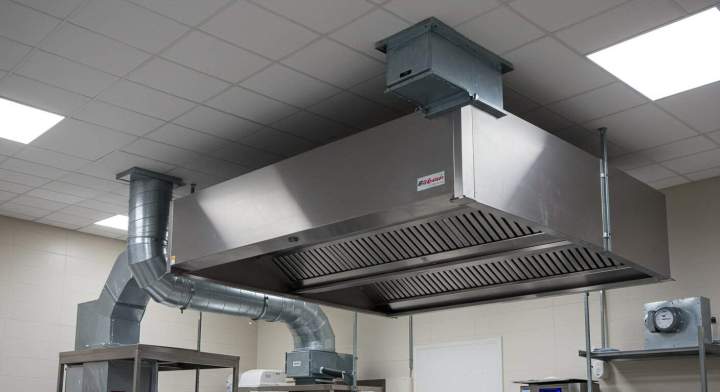Commercial Kitchen Exhaust Systems: Design & Installation Guide
Kitchen Exhaust Linkeo / April 9, 2025

Understanding Commercial Kitchen Exhaust Systems
A commercial kitchen exhaust system is engineered to remove heat, smoke, vapors, and grease-laden air from cooking areas. These systems improves air quality by replacing stale air with fresh air, prevents the accumulation of grease, which can pose fire hazards and maintains a comfortable working environment for staff.
Here is the main components of a commercial kitchen exhaust system :
1. Exhaust Hoods: positioned directly above cooking appliances, these capture smoke, heat, and grease.
2. Ductwork: transport air from the hoods to the outside, often insulated to prevent condensation.
3. Exhaust Fans: create negative pressure to pull air through the system and expel it outside.
4. Make-Up Air Units: introduce tempered, conditioned air into the kitchen to replace the expelled air, maintaining indoor air balance.
Designing an Exhaust System
Factors to Consider
When designing a commercial kitchen exhaust system, several critical factors must be addressed:
1. Kitchen Layout
The configuration of cooking equipment and the overall kitchen layout will dictate hood placement and duct routing. A well-planned kitchen minimizes the distance air must travel, enhancing system efficiency.
2. Type of Cooking Equipment
Different cooking methods produce varied amounts of heat and grease. For instance:
- Grills & Fryers: High grease production necessitates high-efficiency hoods.
- Ovens: Typically produce less grease but still require adequate ventilation.
3. Local Codes and Regulations
Familiarize yourself with local building codes and fire safety regulations, as they can dictate specific requirements for exhaust systems, including hood types, fire suppression systems, and clearance heights.
Calculating Exhaust Requirements
Accurate calculations are essential for determining the right size and capacity of the exhaust system. Key metrics include:
- CFM (Cubic Feet per Minute): measure of airflow needed to effectively ventilate the kitchen.
- Hood Size: generally, hoods should extend at least 6-12 inches beyond the cooking surface to capture all emissions.
A common formula for CFM calculation is:
CFM = Length of Cooking Surface times × Width of Cooking Surface × 100
Installation Considerations
Step-by-Step Installation Process
- Create detailed schematics including duct routes, equipment locations, and electrical requirements.
- Securely install hoods above cooking appliances, ensuring they meet the required height.
- Install ducting, minimizing bends, and ensuring proper insulation to reduce condensation.
- Position fans at the end of the duct system to facilitate efficient air expulsion.
- Install these units strategically to balance air pressure and ensure an adequate supply of fresh air.
Maintenance and Compliance
Regular maintenance is vital for safety and efficiency. Schedule routine inspections to check for:
- Grease build-up in hoods and ducts.
- Proper functioning of exhaust fans.
- Compliance with fire safety standards.
- Condition of filters: they should be cleaned or replaced regularly.
- Performance of make-up air units to maintain proper air balance.
Designing and installing a commercial kitchen exhaust system is a complex but essential task that requires careful planning and adherence to local regulations. By understanding the components, design factors, and installation processes, restaurant owners and kitchen managers can ensure efficient ventilation, enhancing both safety and comfort in their culinary environments.
It is recommended to seek the expertise of a professional for the best results.